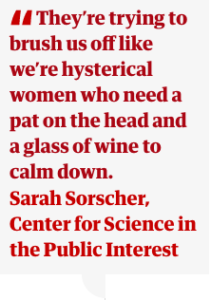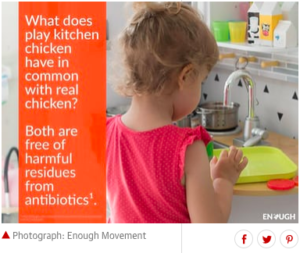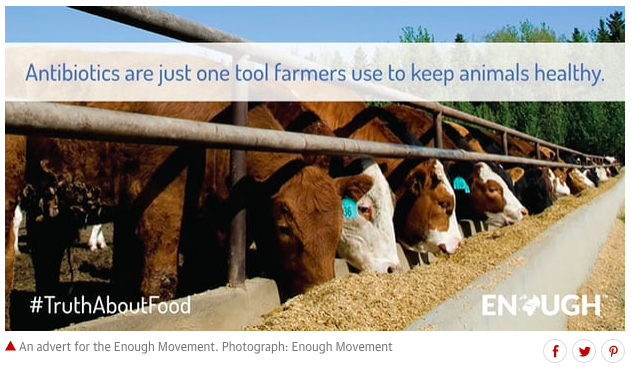The Guardian: Diversion tactics: how big pharma is muddying the waters on animal antibiotics
by Ben Stockton, Madlen Davies and Andrew Wasley | June 19 2018
Antibiotic use on farms is a major cause of human drug resistance. Yet slick social media campaigns – funded by the multi-billion-dollar industry – are confusing and complicating the issue
Slick industry PR campaigns about antibiotics in food are muddying the water around a serious public health risk, say critics.
Pharmaceutical and meat companies are using similar tactics to the cigarette industry, in an attempt to confuse consumers and hold off regulation, despite the fact that the rapidly growing risk of anti-microbial resistance is one of the biggest health risks of our time. It’s estimated that by 2050 10 million people might die a year because we have overused antibiotics.
In one facebook ad entitled “How to survive as a working mom” a stressed woman has a baby on her lap and a phone under one ear. “Breathe,” the advert says. “Pour a glass of wine (if that’s your thing). Prepare your family the chicken. Whether the label says ‘no antibiotics’ or not, the meat and milk you buy is free of harmful residues from antibiotics.”
The Enough Movement – the “global community” behind this advert – promises to tell you the truth about food. But it’s a PR campaign funded by Elanco, a multinational animal drugs company that sells antibiotics for use on livestock. Elanco operates in more than 70 countries and in 2015 accounted for 13% of the veterinary pharmaceuticals market. A subsidiary of pharmaceutical giant Eli Lilly and Company, last year it was valued at $14bn-$16bn (£10.5bn-£12bn).
 Elanco, along with other organisations with vested interests, is using slick advertising campaigns to downplay consumer concerns over giving antibiotics to animals, a joint investigation by the Guardian and the Bureau of Investigative Journalism has found.
Elanco, along with other organisations with vested interests, is using slick advertising campaigns to downplay consumer concerns over giving antibiotics to animals, a joint investigation by the Guardian and the Bureau of Investigative Journalism has found.
Mothers are clearly the target for many of the Enough Movement’s adverts. Some – such as one titled “Eat. Sleep. Mom. Repeat” – make no reference to antibiotics or agriculture at all. Another from its Twitter feed reads: “Making mom friends can be difficult. Making food decisions doesn’t have to be. Whether the label says “no antibiotics” or not, the meat or milk you buy is free of harmful residues from antibiotics.”
These adverts – just a handful of the many posted on social media by the Enough Movement – refer to Food Safety Inspection Service testing, which makes sure the meat on supermarket shelves has no more than trace amounts of antibiotic. But many scientists are more concerned about the rise of antimicrobial resistance – where bugs don’t respond to medicine – than about antibiotic residues. The heavy use of antibiotics on farms is believed to be a major contributor to this problem, seen as one of the most dangerous public health issues of our time. The Enough Movement potentially confuses consumers, who are increasingly looking for antibiotic-free meat, by shifting the debate from resistance to residues.
Sarah Sorscher, Deputy Director of Regulatory Affairs at the Center for Science in the Public Interest said: “Ads like this are patronising. Industry should be looking for ways to address valid consumer concerns. Instead, they’re trying to brush us off like we’re a bunch of hysterical women who just need a pat on the head and a good glass of wine to calm down.”
Besides the Elanco adverts’ tendency for being “grossly sexist”, says Dr Thomas Van Boeckel – an epidemiologist specialising in antimicrobial resistance – they are also “a classic strategy to divert the debate about residues rather than focusing on the core issue, which is the selection for resistant bacteria in the live animals due to the constant exposure to those drugs on the farm”.
Scientists believe that using antibiotics on farm animals is one of the major causes of the growth of antimicrobial resistance. Any resistant bacteria that has thrived across a large herd of animals in close quarters can potentially spread from farms and infect humans through food, contact with farm workers or in soil and fertiliser. Drug resistance has been dubbed one of the greatest public health threats the world faces. It is estimated to kill 700,000 people worldwide, a figure that will rise to 10 million by 2050 if no action is taken.
Ferd Hoefner, a senior strategic advisor at the National Sustainable Agriculture Coalition, believes the way industry has responded to calls to reduce the amount of antibiotics in agriculture is strikingly similar to techniques adopted in the smoking and climate change fields: “PR companies … are just constantly raising doubts. They’ve turned that kind of thing into an art form.”
Prof Ramanan Laxminarayan, director of the US-based Center for Disease Dynamics Economics and Policy, agrees: “It’s not surprising. It’s pretty standard. In the case of tobacco the industry played down the effects of smoking – ‘a few cigarettes won’t hurt you’. They tried to appeal to women by making smoking Virginia Slims a sign of the feminist movement.
Advertisement
“The truth is that companies like Elanco are likely to face significant financial hardship given that many of the world’s consumers will no longer want to buy meat raised on antibiotics.”
 In a 2016 report commissioned by the British government, former economist Lord Jim O’Neill found that out of 139 academic studies – excluding those funded by industry or government bodies – 72% supported evidence of a link between antibiotic consumption in animals and resistance in humans. Only 5% argued that there was no link.
In a 2016 report commissioned by the British government, former economist Lord Jim O’Neill found that out of 139 academic studies – excluding those funded by industry or government bodies – 72% supported evidence of a link between antibiotic consumption in animals and resistance in humans. Only 5% argued that there was no link.
Of the studies compiled by Lord O’Neill, the most recent academic paper to find no link was written by a student at a Hawaiian high school in 2005. Out of four industry-funded papers identified by the review, two didn’t support evidence that banning agricultural antibiotic use would have an effect on the level of resistance in humans.
Even so, one of those industry-funded papers said stricter regulation of newer antibiotics in agriculture could potentially extend their effectiveness in humans. The authors of the study – which was funded by Pfizer, one of the world’s biggest drug companies, and published in 2002 – suggested that recently discovered antibiotics should be used prudently on farms before resistance emerges. But they argue that controlling the use of antibiotics in agriculture after resistance has already emerged will have little impact on the number of superbugs in hospitals.
The Elanco-funded Enough Movement reads like a humanitarian report, offering “practical solutions” on ensuring there is enough food for everyone as the population grows. The ‘movement’, which includes a report, a website and social media adverts, promotes modern farming procedures that could ensure a steady supply of meat and dairy. The campaign’s Facebook page has more than 20,000 followers and Elanco claims its messaging gains 1 million impressions online per week.
In response to the Bureau’s findings, Elanco said: “The Enough Movement works to bring awareness to food security and answer consumer questions about how food is produced. Recent labelling initiatives have increased consumer questions about antibiotic use in animals. And we have a responsibility to answer those concerns, especially when it comes to the safety of the food we eat.”
Sanderson Farms, the third largest poultry producer in the US, launched a similar campaign to Elanco in 2016 as its CEO called meat labelled as “antibiotic-free” as “misleading”. In one TV advert, a man in a supermarket, dressed in a plaid shirt, khakis and a cap, says: “Some chicken companies try to get you to spend more money by using labels like ‘raised without antibiotics’. At Sanderson Farms, we don’t believe in gimmicks like that. No antibiotics to worry about here.” Last month, a report by the investors’ group Farm Animal Investment Risk and Return ranked Sanderson Farms among the worst companies for its policies on antibiotic use in animals.

The Enough Movement said: ‘Recent labelling initiatives have increased consumer questions about antibiotic use in animals.’ Photograph: Enough Movement
Sanderson Farms did not respond to a request for comment, but a statement on its website says it is “committed to taking steps toward finding alternative ways to control disease to reduce antibiotic use, and to work with its drug suppliers to phase out the use of antibiotics that are important to human medicine when alternatives become available”.
Although the majority of the scientific community accepts antibiotic use on farms is a genuine threat to human health, the true scale of the problem remains unknown. And this gap in knowledge has proved fertile ground for the agricultural and pharmaceutical industry to suggest the threat may be at most minimal.
Not only are companies targeting consumers with adverts, the pharmaceutical and agricultural industries are also pumping money into scientific research on antibiotic resistance. Some of these studies either play down the potential risk to human health from antibiotic use in farm animals or support claims that more research is needed before policy decisions are made.
Elanco has indirectly funded studies that point to the need for more research on the link between antibiotic use on farms and resistant infections in humans. Along with other major pharmaceutical companies, including Bayer Animal Health and Boehringer Ingelheim, it is one of 13 members of the Animal Health Institute (AHI), which has funded this work. Eight out of the 13 AHI members listed on its website sell antibiotics for use in farm animals. AHI also spent almost $700,000 on lobbying between 2013 and 2017, according to the Center for Responsive Politics.
A number of companies have fervently opposed stricter regulations arguing that, without antibiotics, not only will animal welfare be compromised but food prices will go up. Until 2017 antibiotics were widely used as growth promoters on US farms, helping livestock grow fatter more quickly. When farm animals are sick it is sometimes necessary to give them antibiotics. But US farmers are still allowed to routinely give them to healthy animals to prevent disease, a practice many believe can often take place as a way of dealing with overcrowding and poor hygiene. This so-called “prophylactic use” of antibiotics is currently being scrutinised in the EU, with stricter regulations under consideration.
 Dr James Rogers, director of Food Safety Research and Testing at Consumer Reports and a former FSIS employee, said: “There is intense pushback because we are talking about an economic effect, that if they were not allowed to use antibiotics, especially for growth promotion, you’re going to get fewer pounds per chicken, which means less money.”
Dr James Rogers, director of Food Safety Research and Testing at Consumer Reports and a former FSIS employee, said: “There is intense pushback because we are talking about an economic effect, that if they were not allowed to use antibiotics, especially for growth promotion, you’re going to get fewer pounds per chicken, which means less money.”
In November the US Department of Agriculture rejected further restrictions recommended by the World Health Organization. The guidelines proposed a ban on giving healthy animals antibiotics important for human medicine. The USDA acting chief scientist, Dr Chavonda Jacobs-Young said they were “not in alignment with US policy and not supported by sound science”. Hoefner, who is a regular attendee at the monthly meetings between industry representatives and USDA officials, described her comment as “outrageous” given the weight of knowledge behind the WHO guidelines.
Last year agribusiness organisations, including all livestock, crop and tobacco industries, spent more than $131m on lobbying in the US, according to the Center for Responsive Politics. Critics say industry is perceived to have been able to tighten its grip on the USDA during the Trump administration, especially on the issue of antibiotic use. Hoefner said: “We were making some inroads in the last administration here in the US, but even then it was difficult. We weren’t making huge strides but we were making some strides. But now it’s totally impossible so we’ll just have to wait this out.”
But Prof Laxminarayan is more hopeful. Referring to Elanco’s Enough Movement, he says: “I see all of this as the last cries before it goes down,” he said. “It will still have a role in animal health, but the days of pushing antibiotics in livestock for growth promotion, their widespread use on farms to prevent disease, are soon to be over.”
